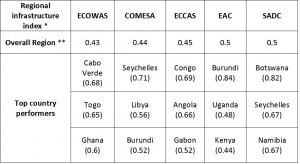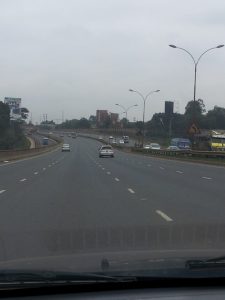Integration may bring important benefits to Africa. It will foster higher growth and development (see Intra-African trade and transportation, Agenda 2063 (II): Connecting Africa through high-speed trains, Regional integration in Africa). Needless to say, regional transport infrastructure improvements play a key role in this.
Africa’s infrastructure deficits, that include transportation and energy access, have been estimated to cost the continent up to 2 percentage points of annual economic growth in 2015, according to the African Union Commission. This is a huge drag for the continent’s economic activity: to give some perspective, Sub-Saharan Africa’s (SSA) real GDP grew at 3.35% in 2015. African leaders’ commitment in Agenda 2063 to accelerate action to connect the continent through a better infrastructure aims at overcoming this situation.
A look at the 2016 regional infrastructure index published by the African Union Commission gives us the opportunity to compare how regional integration varies across African administrative regions.

*Note: The regional infrastructure index ranges from 0, the least connected, to 1, the most connected and it averages the outcomes of 5 indicators: average cost of roaming, total regional electricity trade (net) per capita, proportion of intra-regional flights and the infrastructure development index (transport, electricity, ICT, water and sanitation). Information about each region (ECOWAS, COMESA, ECCAS, EAC and SADC).
**Note: There are countries that belong to more than one Regional Economic Community. The countries’ values correspond to the regional integration within each Regional Economic Community.
The good news is that the overall situation has improved in the last decade. Still, these improvements are distributed asymmetrically across the different African areas.

- Roads: Overall, the continent’s road network has increased notably: since 2006, the yearly average growth rate has been 2.2%, up from 1.8% in the period 2000 to 2005. In the Western region, has increased by 29% this last decade and it has the second highest road density, 10.9, only lower than the Southern region, 18. Central Africa is the only region with a reduction in the road network from 2006 to 2015 (24% decrease) and it continues to be the region with less road density too (only 4.7 km by 100 square km).
- Railways: there are currently important projects in progress: Djibouti-Ethiopia, Dakar-Bamako, Mombasa-Nairobi in Kenya, which is planned to be extended to Uganda, Rwanda and South Sudan by the following years.
- Inland water ways: the navigational line between Lake Victoria and the Mediterranean Sea through the River Nile is the most iconic project under construction.
What’s your experience with transportation in SSA?
Nadim Elayan, Research Assistant at IESE Business School, collaborated in this article.
_____________________________________________________________________________
Related posts:


These are quite impressive development in the SSA region. As more FDIs seek investment opportunities in SSA, I belief there will be more investment on infrastructure sector. This is actually a sector which is currently dominating the East African region/block conversation…. enhancing communication linkages among the six members states through railway, water, air, and road. To illustrate, Tanzania is currently on a process to construct a fast railway line from its east coast in the Indian ocean which will connect with its East African members states of Burundi, Rwanda, and Uganda. Thank you both for this impressive conversation.
Yes, infrastructure industries are strategic sectors as they have the potential to boost development of other sectors. Foreign investors are attracted to them. The problem is that in some cases these investments are carried out in such a way that the local population doesn’t benefit much. While infrastructures themselves are an addition, we need to think carefully about “the how.”
hi
While acknowledging the view of my dear friend Aloysius Newneham-Kahind communication through social networking is also very effective in increasing investment in South Africa.
I agree, and I think your comment complements that from Aloys. While networking is important across the globe, I believe it’s even more critical to business in sub-Saharan Africa, including Southern Africa. If interested, have a look at an earlier post on “how personal networks matter in Africa.”
hi
I think both User comments are important.
Agreed. As I mention in my reply to Shoes, I believe her/his comments complement those of Aloys.
Interesting information on how there is improvement in regional transport infrastructure, and the need for it. And this is quite impressive development in Africa.
Nice and interesting information. Thank you for posting this good
Such good information on posting thanks
http://franchisepk.com/